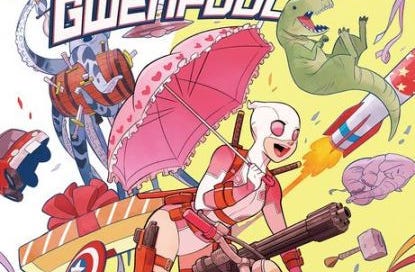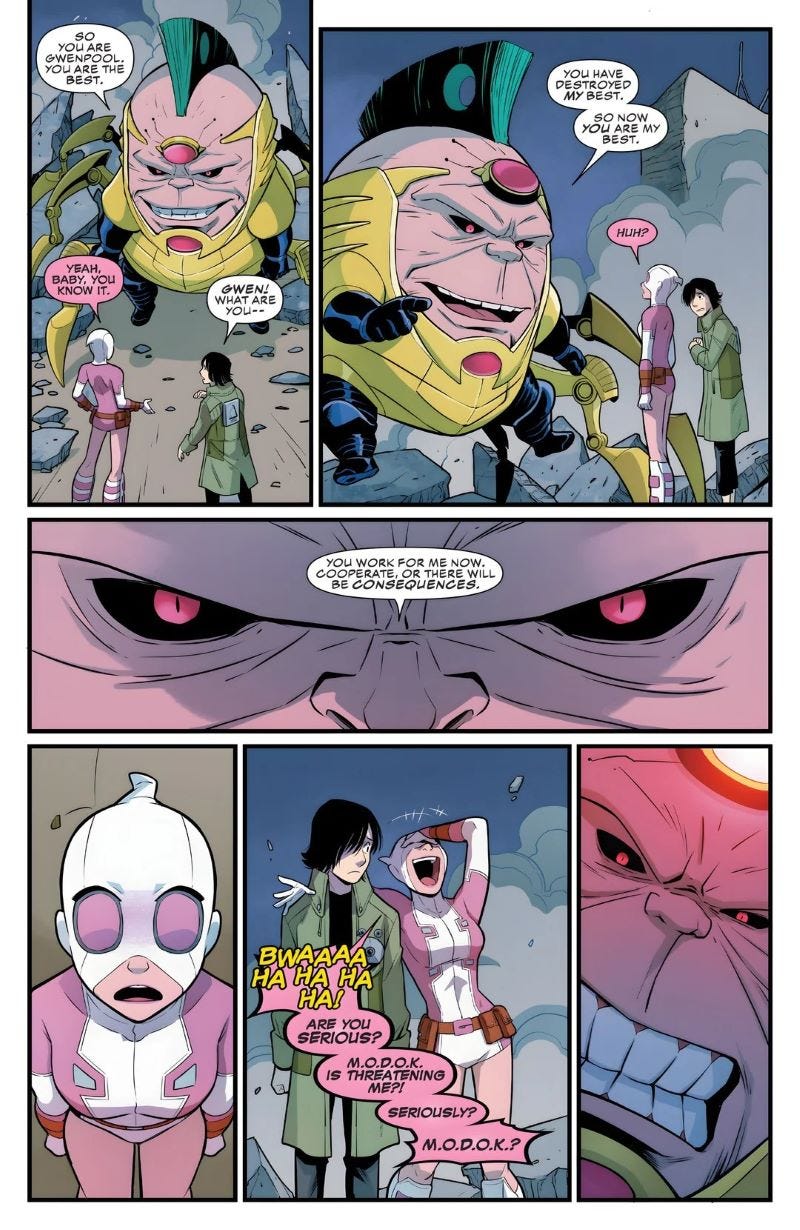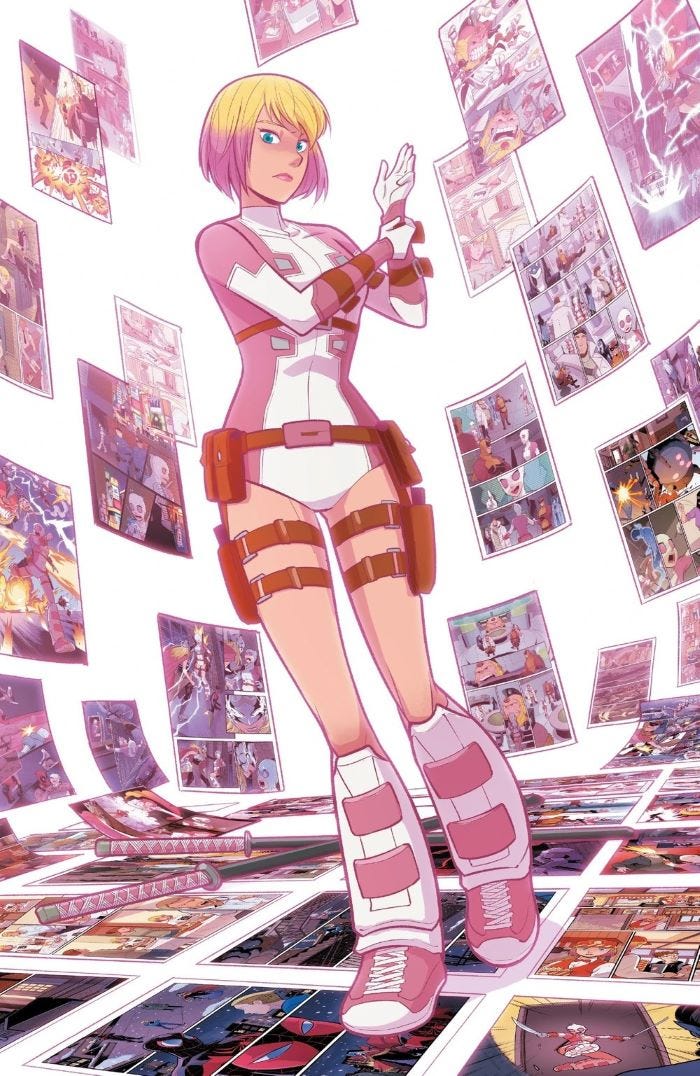The Unbelievable Gwenpool: Just forget all about the fourth wall
In which I find metafictional enjoyment from an unlikely source.
The Unbelievable Gwenpool, Volume 1-5
Written by Christopher Hastings
Art by Gurihiru, et. al.
Published by Marvel Comics, 2016-2018
Buy it
Everyone has certain types of stories that they really like. Among a few other favorite subgenres (stories about time travel, martial arts movies), I really enjoy metafiction. Give me a story where a character learns that they’re part of a fictional setting, interacts with their author, or otherwise breaks the fourth wall, and I’ll eat it right up. So while I wasn’t initially interested in the Marvel Comics character Gwenpool, when I learned that metafiction is her whole deal, I had to read some of her comics. And fortunately, I wasn’t disappointed; these are some highly enjoyable stories that come up with some fun ways to strain against the limits of the Marvel Universe, while also managing to work in some effective emotional stakes.
The character of Gwenpool is one that requires some explaining. Even if you’re already familiar with the workings of superhero comics in general and the Marvel Universe in particular, she has something of a convoluted backstory. And if you’re not well-versed in the ins and outs of these types of stories, the concept may seem completely impenetrable. So let me see if I can explain things.
Gwenpool is sort of a variation on Deadpool, who has become pretty well known due to a series of successful movies. She was originally just a one-off character design created for a variant cover (which, for those who may not know, is a piece of artwork that is used on an alternate version of one of the monthly comic books published by Marvel or other publishers). Marvel had a month of themed variant covers featuring Gwen Stacy (Spider-Man’s girlfriend who famously died back in the 1970s). For a Deadpool comic being published that month, artist Chris Bachalo created a variant cover with a female version of the character’s costume that featured pink coloring and a noted lack of pants. Even though there was only a single image of the character, she became popular enough that Marvel decided to give her her own series.
Despite this origin, Gwenpool is actually unrelated to both Deadpool and Gwen Stacy. She’s a character named Gwendolyn Poole, and she’s somebody from the “real world” who was somehow teleported into the Marvel Universe. As a longtime fan of Marvel Comics, she has knowledge of everyone’s secret identities, and she also knows how these stories work. While she doesn’t have any superpowers (at least at first), she does recognize that the way to survive in the Marvel Universe is to be a superhero. Thus, she goes to a woman who has a business creating costumes for heroes and villains, and due to a misunderstanding, she receives the variation on Deadpool’s costume that people liked so much.
The early stories in the series generally feature Gwenpool getting up to a bunch of mayhem and throwing herself into deadly situations because she’s sure that as long as she’s the main character in her story, the writer will make sure she survives. She does stuff like throwing herself off a building to escape a threat and finding that a truck transporting pillows happened to be traveling below at the time. With her knowledge that she’s in a fictional universe, she also has no compunctions about killing, and she even encourages other characters like Howard the Duck to risk their lives, since she knows that even if they die, they’ll most likely be brought back to life at some point.
That’s all pretty fun, but writer Christopher Hastings (who is probably best known for the webcomic The Adventures of Dr. McNinja) takes some steps to develop Gwen’s character beyond just a happy-go-lucky force of mayhem. Early on, she enlists a teenage boy named Cecil to act as a sort of hacker sidekick, but when she ends up crossing the villain MODOK (the bizarre Jack Kirby creation who is basically a giant head with tiny arms and legs), he promptly kills Cecil and forces her to begin working for him (his organization is also known as M.O.D.O.K., the Mercenary Organization Dedicated Only to Killing). This causes her to struggle with the idea that maybe she’s just a henchman rather than a superhero, and Cecil’s death hits her harder than she expected (but it’s okay, because he comes back as a ghost later, and Gwen does what she can to help him retain a physical body).
However, she manages to turn the tables on MODOK and take over the organization, and she also forms relationships with the other operatives, who include the old-school Captain America villain Batroc the Leaper, as well as a few new creations: the super-healer Mega Tony and the semi-insane sorceress The Terrible Eye. She also interacts with various other Marvel characters, baffling them with her knowledge of their secrets and infuriating them with her cavalier approach to, well, pretty much everything. For example, she runs across Spider-Man Miles Morales and almost exposes his secret identity, then horrifies him when she tries to kill a kid who was planning to set off explosives at Miles’ school. Hastings is good at coming up with interesting ways for Gwen to use her knowledge of the Marvel Universe to solve problems in unexpected ways, but he also conveys the frustration that other characters feel when interacting with her, since she keeps referring to things like crossovers, tie-ins, and guest appearances.
In one interesting storyline, Gwen and her other mercenaries (including a bunch of MODOK’s former henchmen who she dresses up in costumes identical to hers and calls the Poole Boys) end up working for a rich guy named Vincent Doonan whose main focus is stopping the ridiculous things that constantly happen in the Marvel Universe and threaten his ability to just live a peaceful life. While he initially hires Gwen to get rid of a threat from a bunch of squidlike aliens who have invaded New York, she does the opposite of what he wanted, bringing the fight to his small neighborhood and turning it into a war zone between her mercenary forces and a bunch of alien ships. But when he get upset at how she has completely failed to do what he wanted, it’s revealed that he’s actually a Doombot who had been trying to live as a normal human and leave behind all of the superheroic trappings of his previous existence.
As enjoyable as all of this is, Hastings isn’t satisfied with just continuing Gwen’s hijinks, so he introduces the idea that when she was pulled into the Marvel Universe, her brother was too, and he wants to put her back into her previous life and make things go back to normal for their family. Through some weirdness involving time travel and interdimensional portals, he brings her back to the “real world” and changes the past so that she never traveled to the Marvel Universe in the first place. Except this doesn’t work out like he thought it would, and it ends up triggering some new abilities in which Gwen learns to manipulate the panels of the comics pages themselves and even exit them into a sort of interdimensional space that she refers to as “the gutter” (which is the term that is often used for the spaces between panels on a page of comics.
This leads to a whole new set of crazy adventures, as Gwen figures out how to exit and re-enter her adventures at any point, jump around between different pages, pull objects from one panel or page into another, and engage in all manner of metafictional activities. But at the same time, she struggles with what this means for her and how her actions may affect others in the Marvel Universe. She interacts with a future version of herself that has turned evil, and she worries that this might be the inevitable result if she can’t find a way to fit in alongside other characters. As the series nears its conclusion, she worries that its end (which she can see approaching whenever she exits the pages she’s currently on) will mean her death, the disappearance of characters that were created for her series, and the end of the characterizations of certain members of the supporting cast. It ends up being a thoughtful examination of the ways that these characters endure, the places they have in the hearts and minds of readers, and the reasons writers and others involved in creating stories should take them seriously even if they seem frivolous (which is kind of similar to the theme of John Scalzi’s novel Redshirts).
As enjoyable as Hastings’ writing is, it probably wouldn’t work nearly as well if most of the comic wasn’t illustrated by Gurihiru, a team of two artists from Japan who are known for their appealing manga-inspired style. They make Gwen’s adventures appealing and dynamic while selling her emotions as she goes from elation to living among her comics heroes, to shock and sadness when things don’t turn out as expected, to a sort of resignation to her fate and hopefulness that she’ll be an ongoing presence in the Marvel Universe. As confusing as some of the scenes can be when Gwen is jumping between different comics pages, the art is always clear and easy to follow. With this art team, the comic is a pleasure to read at every level.
I don’t know if there’s anything super-innovative here or any ideas that haven’t been explored elsewhere to better effect (notably in Grant Morrison’s Animal Man series from back in the late 1980s), but as I mentioned, I have a soft spot for metafiction, and this sort of thing is right up my alley. It’s wild and wacky, full of goofy jokes and general silliness, but it takes the time to develop characters and make us care about them, even if they themselves are noting the inessential nature of their stories. If you enjoy this sort of thing as much as I do, and you know enough about Marvel and comics in general to get at least some of the in-jokes and commentary, this should not be missed.










It's easy to like Gwenpool. This would be a better use of MODOK in the MCU than what we saw in Antman
Usually Mary Sue types are annoying, but she seems interesting.